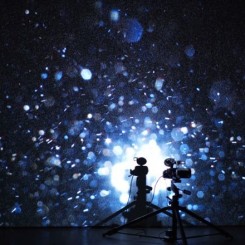by Lynne Howarth- Gladston
“Dust”: solo exhibition by Wu Chi-Tsung
Site Gallery (1 Brown Street, Sheffield, UK) April 4–May 31, 2014
Taken out of cultural context, one might be tempted to read “Dust”, Wu Chi-Tsung’s most recent exhibition at the Site Gallery in Sheffield, solely from an international art world perspective. Both of the works included in the exhibition, “Dust” and “Crystal City” present viewers with a now all-too-familiar “black box” experience. In the case of “Dust” (which was produced by Wu during an earlier residency at Site Gallery) a field of intensely bright light is projected onto a wall within an almost completely darkened space capturing, through careful use of lenses, the colorful play of fine speckles of dust within the immediate atmosphere—an image reminiscent of mappings by the Hadron Collider. Art metaphorically meets science with infinitesimally small particles moving about in what first appears to be an entirely random way, but which on further viewing reveals an almost graphically linear chaotic order. Trace patterns emerge and disappear, picked out in a range of muted jewel-like colors. In spite of its evidently minimal technical means, “Dust” is a sublimely mesmeric, magical work that opens up a transcendentally indeterminate vision of elements of our surroundings which would otherwise remain unseen.
“Crystal City” gives rise to somewhat different feelings. This time, the work is set in a dimly-lit room containing an accumulation of transparent plastic packaging boxes of different shapes and sizes set out like a city planner’s architectural model. To the viewer’s right, there is careful order, and to their left an increasingly ruinous disorganization. Dividing the space between the viewer and the boxes is a light projector which moves continually back and forth along a dolly track projecting shifting images of the crystalline outlines of the boxes onto the back wall of the gallery space. The resulting panorama propels the viewer into an immersive virtual space as though she or he were moving by car through an imagined Ballardian modernist-brutalist city. The aesthetic effect of this shifting projection is initially less magical than that of “Dust”. The moving architectonic shapes and superimposed patterns playing out on the wall of the gallery space suggest a dystopian allegory which incites strong feelings of alienation and disorientation, and, as the projector moves from right to left, an inexorable shift from order to disorder. With prolonged viewing, not only is order restored, but feelings of alienation and disorientation are also overwritten by a faint state of pleasure.

Wu Chi-Tsung, Crystal City 003 – Voyage, 2010 – 2014. Image courtesy Site Gallery
吳季璁,《水晶城市 003 — 漫遊 》,2010,图片版权Site Gallery
It would, however, be shortsighted to read Wu’s work simply from this relatively detached, internationalist point of view. It is also possible to detect in Wu’s work traces of specifically Taiwanese-Chinese cultural perspectives. In the case of “Crystal City”, there are discernible formal similarities between the work’s shifting graphic projection of architectural order and Song-dynasty hand-held scrolls—which in some cases take the viewer vista by seamlessly unfolding vista from natural landscapes through to the ordered centre of an urban space and then back to natural landscapes.
“Dust” and “Crystal City” are also open to interpretation with reference to a range of concepts developed as part of the extended Chinese intellectual tradition. “Dust” and “Crystal City” present minimally graphic images that nevertheless reveal initially obscure visual patterns and/or evoke relays of changing sensation. With regard to both works, one is reminded not only of the traditional Chinese concept of “jingshen” (spirit) but also the related term “jing qi”: the former referring to the notion of purest or quintessential (jing) inner force (shen) and the latter—which is to the fore in Daoist meditation texts—that which might be considered as an “essence”. The combination of the terms jing and shen is first found in the classic text the Zhuangzi where they are brought together to signify the workings of the human mind as an “essential spirit”–a usage still important to contemporary Chinese philosophy.[1] As such, the shifting patterns revealed by “Dust” and “Crystal City” may be interpreted as partial products and analogs of an essential human consciousness projected as part of a much larger and cosmic spiritual order.
As Wu himself acknowledges, “Dust” and “Crystal City” also evoke meditative states. Here, one is reminded of the Buddhist concept of nirvana as a fundamental negation of human desiring that reveals true consciousness—the dissolution of human consciousness into that of a larger cosmic order. In this regard, the projection of ambient dust patterns as part of “Dust” might therefore be seen as redolent of similar visual phenomena found within Buddhist Temples in China, where the atmosphere is often heavily laden with ash from the burning of countless incense sticks—and by extension the Buddhist conception of existence as one of shifting myriad dimensions and perspectives.
Of additional significance here is the concept of ziran (spontaneity). While “Dust” and “Crystal City” are carefully (pre)meditated works that reveal their technical means as part of the viewer’s experience, both, and in particular “Dust”, also give rise through that careful (pre)meditation to stochastic interaction between projection and image, and between the viewer and the viewed (human desire surrendered to an absence of control). In the context of Daoist thought, human spontaneity, as exercised through wu wei (non-action), is crucial to an accordance with the Dao, or essential way of nature. As stated in the Chinese classic, the Daodejing (by Laozi), “[t]he way does not go against spontaneity […] [h]eaven and earth trust what is so of itself; they neither act nor make […] [t]he myriad things manage themselves by themselves; thus they are not benevolent. The benevolent person must make, establish, promote and change things”; [spontaneity is] “what is so of itself […] not making and not positively acting”.[2]
The technology used by Wu may therefore be seen as an interstitial instrument in the spontaneous re-creation of an essential non-desiring spirit. This is, however, only a partial reading.





